 ?
? ?
?I set up QCUIAG in October 1998, initially as a manually operated mailing-list/discussion-group.
The aims of the group were to share experience, ideas and results of astronomical imaging by means of unconventional electronic imaging devices such as webcams and surveillance video cameras. The language of the group was to be English.
We were to probe the limits of these devices and to try to extend these limits by producing software and/or hardware modifications, hopefully, to achieve extended exposures and produce images of deep sky objects, as well as improving the quality of images of solar system objects.
Within the first month, this website was born and it was to become the 'shop window' for QCUIAG. Initially, each member had his/her own section on this website where their results and research was published. The first year saw membership grow to about 40 members, and we started to see some membership overlap with the already well established Francophone Astrocam group. Since that time we moved over to the automatic Listbot and then to what has now become Yahoogroups and the membership increases steadily as can be seen on the front page of this website. Eventually, a group becomes large enough to have enough members with the right combinations of expertise so that their interaction can lead to significant advances. This group is proof of that premise. Later, when membership became too large to sustain individual members' pages on this website, the site evolved into a more general display of the work of this group.
During the first year, interaction between members helped them to achieve significant improvements in their images of the Moon and planets.
The first breakthrough in deep sky imaging came in the early autumn of 1999. Dave Allmon then of Kansas, discovered that sometimes his B/W quickcam software 'broke' and when it did, long exposures became possible.
The Connectix B/W and colour webcams had software that actually had long exposures built into it. The trouble was, that it simply didn't work. Well, it didn't work unless the software spontaneously 'broke'. The task was to discover how to 'break' the software at will. The Connectix software engineers did look at this for us, but to no avail. Eventually, Dave Allmon, a Linux man at heart, discovered that there was Linux code that was able to 'talk' to the B/W camera and control the length of the exposure of this frame-transfer device.
Dave produced a pair of programs to run under Windows. These programs are called Darkgen and QCV2. QCV2 is the software which controls the camera and takes the exposures. It uses the ported Linux code and does not use the Connectix Video for Windows drivers. He also discovered that a very simple hardware modification, the cutting of a single wire to disable antiblooming, completed the camera system, and true long exposures were possible. QCV2 is the software that we use today to capture long exposures from B/W Connectix QuickCams.
I remember Dave coming back from a trip to the mountains where he had taken his camera and scope and posting this image to the group:
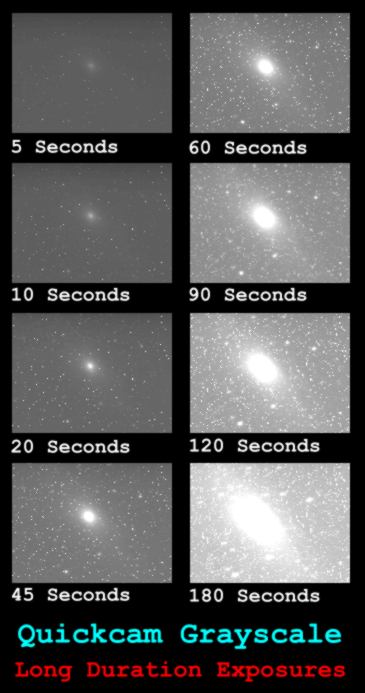
This was Dave Allmon's proof that he had, in 1999, cracked the problem. We had made a significant leap forwards, and with the very camera that Dr. John Buchanan had said (Sky and Telescope June 1998) was not capable of deep sky imaging.
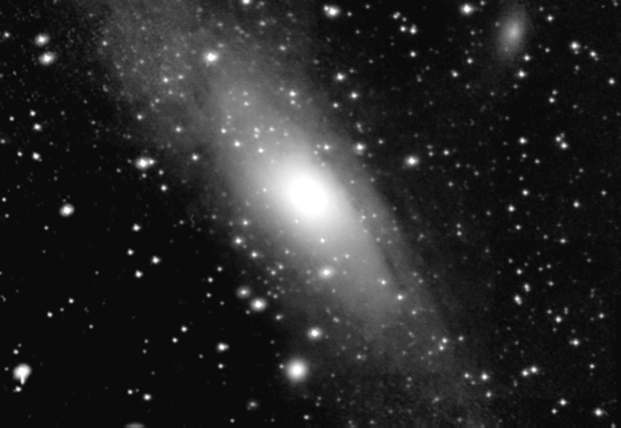
The Andromeda galaxies by Dave Allmon with a B/W Connectix QuickCam
In 1999-2000, Colin Bownes produce Vega, a brilliant piece of software designed to capture BMPs and AVIs from webcams and surveillance cameras. This software evolved to meet subsequent challenges.
In the spring of 2000, Juergen Liesmann published deep sky images taken with a low-light surveillance camera. This image of M13 is one of them:

Juergen's software, written in Java and running under Linux, was able to sum large numbers of video frames, each of 1/50s exposure, into deep Fits files. Off-chip video integration was well and truly under way. Juergen ported his program over to Windows, but the Java environment in which the code ran was too much for some of the humbler computers in use by the group. Juergen had demonstrated that long exposures could be synthesised from very short exposures.
In the summer of 2000, I persuaded Bev Ewen-Smith of the COAA observatory in Portugal, to write a program from scratch that would do video integration, and that would be able to run on any machine capable of running Windows 9X.
Thus AstroVideo software was born and has evolved at a phenomenal rate to support all of the subsequent developments made by QCUIAG. My image of the Horsehead nebula and NGC 2023 was taken by Astrovideo which automatically aligned and summed video frames produced by a second generation surveillance camera. This camera from the Mintron stable, is itself capable of off-chip integration of up to 128 video frames, whilst outputting a continuous PAL signal (the discovery of this kind of camera was a significant advance for QCUIAG):
'Long' exposures were no longer in the exclusive realm of astronomical CCD cameras or the humble B/W Quickcam.
Vega also quickly evolved to be able to synthesise individual long exposures by summing video frames.
AstroVideo evolved further, to incorporate full colour separations and to do virtual tracking where captured video frames are aligned on the fly and are able to follow the wanderings of periodic error without having to control the scope drives. The incredible Drift Integration was incorporated into AstroVideo to allow the capturing of synthesised long exposures from cameras on totally undriven mounts, without any star trailing.
The next significant advance was made in the summer of 2001 by Steve Chambers. Steve produced a modification of the Trust SpaceC@m, a CMOS based webcam. This modification was able to take useful 'long' exposures of up to about 5 seconds. Despite the fact that this is such an inherently insensitive device, Derek Francis and myself were able to use it to image some deep sky objects such as M13 by video integration with AstroVideo:
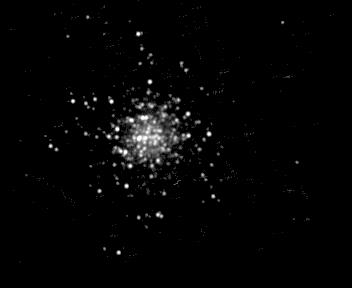
Steve and I discussed the CMOS device and he decided that rather than following up on this device, he would attempt to apply his ideas to a more light-sensitive CCD based webcam, the Vesta 675. Within about three weeks, Steve had produced a modification of the Vesta 675 (the Vesta 675 SC) that was able to take one-shot full colour true long exposures. The CMOS device had almost immediately been relegated to the status of a curiosity. However, if CMOS sensors ever become suffciently sensitive to be genuinely useful for deep-sky imaging, then this type of modification may make a comeback. Further improvements were made to the design of the Vesta modification and it was extended to several other cameras. A very satisfying outcome of this research was the agreement between SAC-Imaging in the USA and the inventor of the remanufacturing technique, for an entry level astronomical CCD camera based on these processes, to be manufactured. This camera is the SAC7: In the space of a few months, the entry level of astronomical CCD imaging had been shifted to lower cost devices, never before available: Other devices have since followed and SAC-Imaging has increased in importance as a result.
I have taken very satisfying images with this device, such as M27 captured and synthesised by AstroVideo:
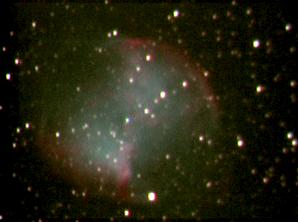
It is my hope, that devices like the SAC7, or cameras re-manufactured by members themselves, will start many more amateurs on the road to deep sky imaging. The AstroVideo software kept pace with and fully supports the SC long exposure modifications.
New software called K3CCDTools was released by Peter Katreniak that also supports the SC modifications as well as unmodified cameras.
Other members such as Derek Francis set standards of re-manufacturing design, producing devices re-built to the highest standards, such as this Vesta 675 SC:
Steven mogg developed a set of low cost adapters that allow the connection of webcams and surveillance cameras to most telescopes. A Mogg adapter is used in Derek's design above.
The innovation continued in the autumn of 2001 with the modification by Jon Grove, of a low light video surveillance board camera to allow long exposures. We have taken a number of deep sky images with this camera, such as Jon's M42-M43 image below:
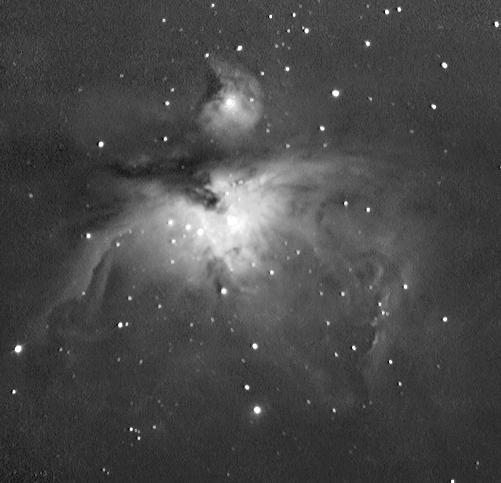
Jon Grove worked on the synchronisation of image release by the camera and capture by the computer and developed the sofware iCatch that captures long exposures from his modified surveillance cameras.
QCUIAG is achieving and surpassing its initial aims due to the innovation and cooperation of our members.
In February 2002 Jon Grove released the first images from his completed new surveillance camera modification, by producing the best image of M81 that had been produced by QCUIAG at the time:
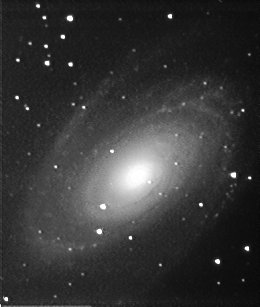
M81 By Jon Grove
This research by Steve Chambers and Jon Grove led to the development of the Artemis cameras
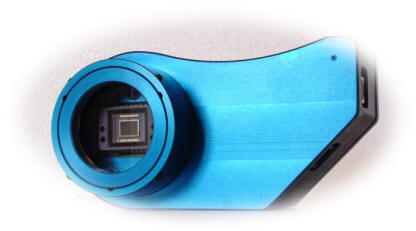
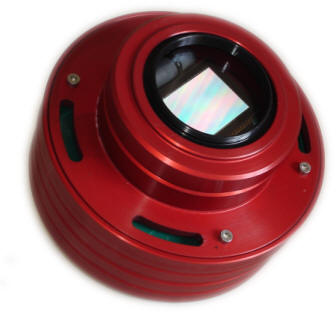
These cameras are high end devices deriving from the work done within QCUIAG. Artemis cameras feature frequently in high quality, high resolution deep sky images posted on QCUIAG
Copyright © S.J. Wainwright